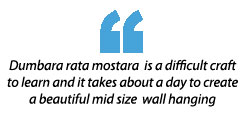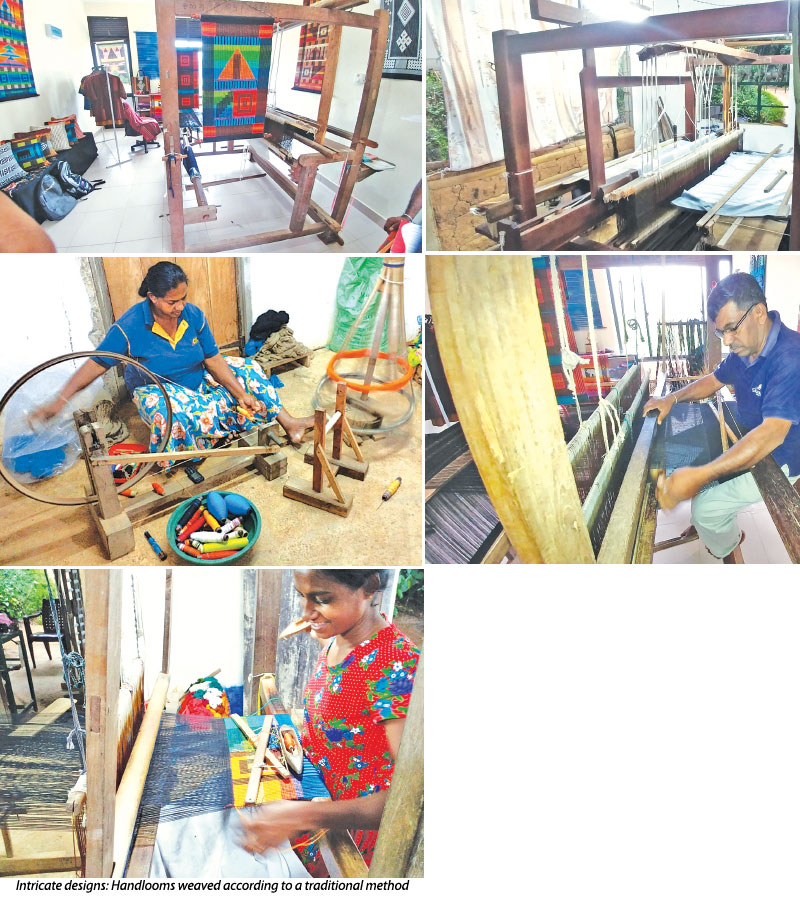
Surrounded by picturesque mountains, the village of Talagune produces attractive handloom products, unique to the Dumbara valley. The handloom culture in Talagune has its roots in the distant past. The handloom craftsmen of the village have provided clothes and decorations to the Sri Dalada Maligawa and King Rajasingha’s royal palace.
 In an effort to find out more information about the handloom culture at Talagune, the Sunday Observer met with craftsman Chandana Yapage who runs a handloom crafts shop in the Dumbara town. Speaking to us, Chandana enlightened us on the history of the Dumbara crafts. According to historical records, when King Rajasingha was walking through the rural villages of the Kandyan Kingdom, he had met Tikirathi the “muthtamma” of Chandana. Impressed by the beauty of the intricate designs created by Tikirathi, the King had asked her to provide clothes for the royal palace.
In an effort to find out more information about the handloom culture at Talagune, the Sunday Observer met with craftsman Chandana Yapage who runs a handloom crafts shop in the Dumbara town. Speaking to us, Chandana enlightened us on the history of the Dumbara crafts. According to historical records, when King Rajasingha was walking through the rural villages of the Kandyan Kingdom, he had met Tikirathi the “muthtamma” of Chandana. Impressed by the beauty of the intricate designs created by Tikirathi, the King had asked her to provide clothes for the royal palace.
Evidence of Talagune village providing clothes for the royal palace of the Kandyan Kingdom can be found in the Archives. A picture of Tikirathi the Muthtamma of Chandana who first created Dumbara rata mostara and the ‘diyakachchiya’ which the Kandyan King used while bathing is displayed at the Colombo National Museum.
Designs
Handloom products in Talagune are weaved according to a traditional method using traditional designs and paduru rata. During the period of the Kandyan Kingdom, cotton farms were cultivated in the village to extract the main raw material needed for the Dumbara rata handicraft, with the leaves and the barks of trees being used to colour the cotton threads. A weaving machine known as the “alwale” machine was used for weaving in Talagune. It is with pride that Chandana spoke about the Talagune village which started the Dumbara rata mostara. He said, it is the only place which has authentic dumbara rata mostara in Sri Lanka.
Chandana is a 7th generation descendent of Tikirathi Muthtamma who started the dumbara rata mostara. The family occupation has now moved into the 8th generation with Chandana’s daughter taking to the profession. She has enrolled herself at the National Handicrafts Institute to gain a wide theoretical knowledge about the industry.
The main raw material, cotton thread, used in the production of dumbara rata mostara is brought from Colombo. The price of cotton thread is a challenge to the industry, and the handloom craftsmen have had to increase the price of their products due to the price increase of cotton thread.
They have to put in a lot of effort and time into making dumbara rata mostara. Chandana claims, it is not very hard to sell the products. The bulk of the products are sold in Colombo, and most sales are connected with the tourism industry.
The craftsmen do not directly export their products to foreign countries. Exports are carried out by institutions in Colombo. Many tourist hotels in Sri Lanka display the handicrafts of Talagune, and Chandana has received an award from the Central Province Industry and Business Development Authority in recognition of his services.
Government and non-governmental organizations can help the industry by providing information and knowledge to local and foreign tourists about the handloom industry at Talagune. If tourists are made aware of the dumbara rata mostara industry, it would be beneficial for both, the seller and the buyer because they would both gain financially, and it would increase the demand for the products. If the village is promoted among tourists it would also benefit the villagers who are not involved in the industry.
Chandana says, the lack of skilled workers was one of the main obstacles to their industry. He said it is disappointing that many young people don’t understand the value of the dumbara rata mostara industry and even the younger members of their families still need confirmation about the industry being a safe financial option.
Lack of skilled workers
They need an assurance that it would give them a financially secure future. The fact that the handloom craftsmen are not provided with some sort of protection against illness or old age is seen as a risk. It is important that the authorities provide some sort of financial security to the handloom craftsmen.
With the opening of his shop and cottage industry Chandana has provided jobs for three persons in his village. Around 70 people belonging to eight traditional families maintain the handloom industry, while providing job opportunities for other villagers. Products such as cushion covers, key tags, slippers, shirts, table mats, table runners, bed runners, sarees and sarongs are created by Talagune handloom craftsmen.
Dumbara rata mostara is a difficult craft to learn and it takes about a day to create a beautiful mid size wall hanging.
Chandana says they pay the newcomers an allowance even during their training period. They normally train a newcomer up to the level where they are able to create a small piece within about three months.
Commenting about their future expectations, Chandana said, they hope to convey to the nation that the dumbara rata mostara industry should be preserved as it is a national heritage and an industry that can be practised at home leisurely while bringing mental peace.
He requests support from the authorities to preserve the industry. Chandana said, they expect to develop the industry with new designs and find ways to source raw materials brought easily and cheaply. There is also a proposal to provide tourists a chance to stay a while in the village and gain hands-on experience in operating the machines while experiencing the Kandyan village culture.
